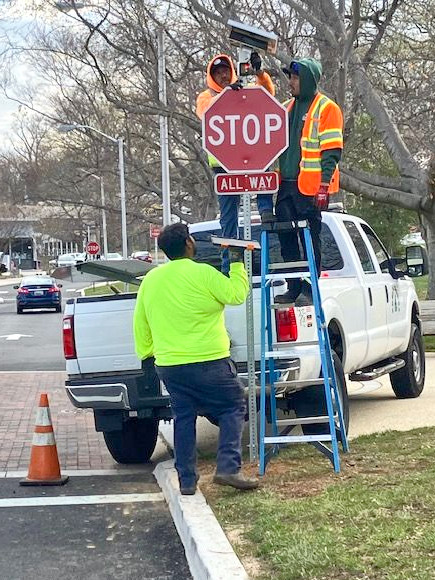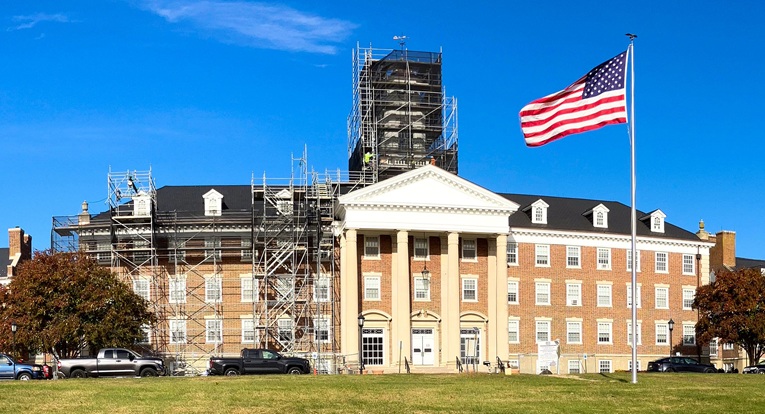The Greenbelt City Council held its third budget worksession on April 2 to discuss the proposed Fiscal Year (FY) 2026 budget for Public Works and capital projects. The capital projects budget will be covered in a separate article.
After introducing the city staff in attendance, City Manager Josué Salmerón noted that many of the things that are visible and touch Greenbelt residents every day are done by Public Works. Mayor Emmett Jordan added that Public Works employees also serve as first responders in snowstorms and address other things that need immediate attention.
Budget Overview
Salmerón stated that the department has tightened their FY 2026 budget by keeping a few positions vacant: assistant director for operations, a building maintenance position and a parks position. The other significant difference in this budget is an adjustment to waste collection: a 20 percent phased increase (over two years) due to an increase in the county’s landfill tipping fees. This will be the first increase in nine years.
Highlights
Public Works Director Brian Kim reported some news and accomplishments. The solar farm that the city has subscribed to (Clagett Farm Community Solar Project) should go online imminently and could offset about 60 percent of the cost of electricity used by the city. The department expects to meet or exceed their grant goals for upcoming fiscal years which would cover about 15 percent of the annual budget. The department has been awarded a Maryland Smart Energy Communities grant to replace the chiller at the Community Center and a Community Development Block Grant for Cherrywood Lane roadworks and concrete improvements. Finally, Kim reported that the department currently oversees over $6 million in projects to improve and maintain the city’s infrastructure.
Council Questions
Jordan asked if the vacant positions will have an effect on overtime and comp time for other Public Works staff. Salmerón responded that Kim had previously held the assistant director for operations position and has been able to absorb some of those job responsibilities into his current role. Kim confirmed that as technology and budget allow, the department is transitioning from gas-powered to electric tools. When asked about playgrounds he said they do quarterly and weekly inspections, noting that a staff member is now certified for playground safety inspection.
Waste Collection
Salmerón reported that options are being considered to reduce the amount of landfill trash generated in the city. One is a “pay-as-you-throw” model that includes a flat fee for pickup plus a cost based on the trash set out for pickup, so customers who generate more trash pay a higher cost. According to Tom Taylor, who spoke for the city’s Green Team, this approach incentivizes residents to think about what they’re sending to the landfill. He said there’s an opportunity to get into a pilot project that would fund “pay-as-you-throw” and an educational component for one year. Ideally this would be combined with integration of the food scrap compost program into the city budget to extend it beyond the grant that currently funds it. Salmerón said that it may be advantageous for the city to take over waste collection in private residential communities, which currently pay private contractors for waste removal, to reduce both the number of heavy vehicles on city streets and overall landfill waste by encouraging their participation in the composting program.
Councilmember Danielle McKinney asked about disposal of nonrecyclable items dumped at city recycling centers. Environmental Coordinator Kevin Carpenter-Driscoll said that’s absorbed in personnel costs. Salmerón added that when taken to the landfill dumped items add to the tipping fees. He reported that recently a $30,000 camera trailer at the Hanover Parkway recycling facility was demolished when a driver ran into it, and illegal dumping has increased there with no surveillance. The city is hoping to get a replacement trailer through the driver’s insurance company but is also considering stationary cameras for that location.

Traffic Lights
Jordan asked about the flashing lights that have been added to some stop signs. Kim said that effort is spearheaded by Planning and Community Development, with Salmerón clarifying that they’re being paid for by some of the American Rescue Plan Act (ARPA) funds allocated to bike-pedestrian improvements.
Jordan noted that the traffic light at Green Ridge House, which is one of two lights the city is responsible for (the other being at Hanover Parkway/Ora Glen Drive in agreement with the State Highway Administration), does not meet current standards but was told there is no funding in the FY 2026 budget to replace it.
Planning and Community Development Director Terri Hruby reported that solar-powered rectangular flash beacons will be installed at new pedestrian crossings at Motiva apartments, Springhill Drive at Cherrywood Lane, and Hanover Parkway at Ora Glen, with flashing yield signs installed at other locations along Hanover Parkway. She said there are no plans to install more speed humps but that they are a tool available to address traffic calming requests.
Performance Metrics
Councilmember Kristen Weaver said that it appears from the budget that no bus stops had been made more accessible and that better metrics are needed to document what work has been completed and what still needs to be done. Hruby reported that 59 bus stops are being improved with ARPA funds so are not included in the Public Works budget. She said metrics will be made available once updated bus stop information is added to the city’s Geographic Information System. Weaver also noted that for parks, where acreage generally does not change from year to year, perhaps number of cleanups or other metrics should be devised to demonstrate accomplishments.
Resident J Davis echoed the need for more Public Works performance metrics, saying that McKinney had suggested reporting the number of responses to resident requests. Davis also suggested reporting the number of maintenance tickets received and responded to.
Accessibility
Resident Michael Hartman asked about the ramps being constructed to improve bus stop accessibility, which Kim clarified are actually curb cuts. Hartman then asked if there is anyone on staff charged with considering accessibility by disabled residents for city projects. Kim replied that the city’s concrete contractor is well aware of Americans with Disabilities Act requirements but no staff member specifically has that expertise, and there are not sufficient funds to hire someone for that role. Salmerón said that some training may be needed but that accessibility is something that all employees should be tuned in to and the city is getting better, adding that changes that address accessibility also are being made to the city website and social media posts.



